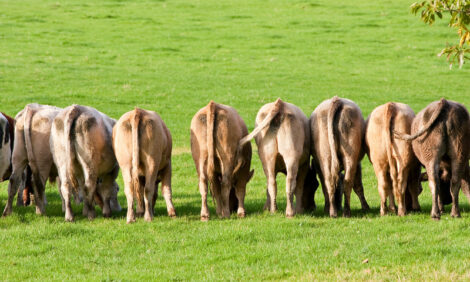



Dairy Herd Owners Cut Replacement Heifer Costs
US - Seven-dollar corn has dairy producers looking for ways to cut costs, says Joe Horner, University of Missouri Extension dairy economist. An overlooked option for saving money, enough to affect the profit margin, is using grass instead of grain or silage to grow replacement heifers.
"Dairy producers must look at every means to trim costs," said Horner, one of the MU organizers of the biennial national Dairy Grazing Conference held in Missouri.
A major theme of the 2011 conference, July 6-8, in Joplin, Mo., will be cutting costs for heifer development.
"Raising heifers on rotational grazing systems will be the subject of one talk and two farm tours," Horner said. "High-quality forage with well-managed pastures can cut purchases of grain and concentrate. That can save hundreds of dollars per heifer."
On high-quality forage, heifers grow to optimal size and weight at calving time in 24 months of age, he said.
Holstein heifers must gain 1.8 pounds per day from birth to calving to keep herd replacements on schedule. Smaller crossbred heifers must gain 1.4 pounds per day. "Those goals are possible with quality forage and management," Horner said.
"It is not enough to just quit feeding supplement and turn heifers out on open pasture," he added. "That won't work."
Dairy budgets show that Missouri producers typically spend hundreds of dollars on grain to raise replacements, Horner said. At today's feed prices, $200 per heifer could be trimmed with good grazing.
"Dairy farms usually have almost as many heifers on the farm as milking cows. With today's feed costs, that really adds up," he said.
Dennis Turner, of Heifer Haven, Hartville, Mo., will speak on "Managing Dairy Heifer Profitability in a Pasture System." He raises commercial heifers on contract for dairy-herd owners.
He will appear on the program, July 6, at the Holiday Inn Convention Center, Joplin.
On July 8 he will open his management-intensive grazing operation for tours by registered participants. He has 300 acres of improved pastures with capacity for 600 replacements. In addition to feeding, he offers health, nutrition and reproductive protocols, including artificial insemination.
Horner said Turner was one of the first dairymen in the state to switch to managed grazing. "The first use of rotational grazing was for raising heifers," Horner recalls. "Then milking-herd owners picked up the idea of grazing to cut dairy-cow feed costs."
Somehow, the idea of raising replacements got put on the back burner. When corn was about $2 a bushel, it was easy to just feed a few buckets of grain to the heifers, Horner said.
"Now grain is a major expense in raising replacements on conventional dairy farms," he said. "Grazing has become something any dairy farmer can use to cheapen production costs."
On July 7, one of four featured farm tours will be at Friend Heifer Ranch, Aurora, Mo. This operation raises replacements for New Zealand milking herds located in southwest Missouri.
"New Zealanders have a way of cutting almost all grain from their heifer development," Horner said. "Intensive management includes growing quality forages and rotating to fresh grazing paddocks about every day. Quality grass can meet the nutritional needs of growing heifers."
Much of the grazing conference will be on how to grow and manage quality grass that supports milk production.



